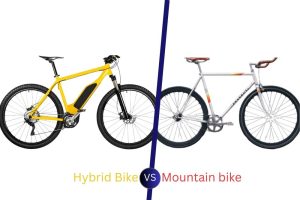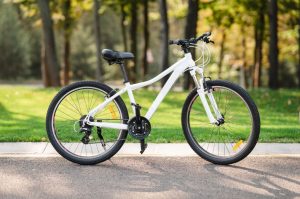
Hybrid bikes and mountain bikes are two popular types of bicycles, each designed with specific purposes and features. Here’s a comparison between hybrid bikes and mountain bikes:
Hybrid Bikes:
1. Versatility: Hybrid bikes are designed for a combination of on-road and light off-road use. They offer a versatile riding experience, suitable for commuting, recreational riding, and occasional gravel or packed dirt trails.
2. Frame and Geometry: Hybrid bikes typically have a more relaxed and upright riding position, providing a comfortable and stable ride. The frame is generally lighter and more agile than a mountain bike.
3. Tires: Hybrid bikes have medium-width tires with a semi-smooth or slightly treaded pattern. This tire design offers a balance between speed on pavement and grip on light off-road surfaces.
4. Suspension: Most hybrid bikes do not feature front or rear suspension systems. They rely on the tire volume and frame geometry to absorb vibrations and minor bumps.
5. Gearing: Hybrid bikes often have a wide range of gears suitable for different terrains, with a focus on providing efficient pedaling on roads and moderate inclines.
6. Accessories: Hybrid bikes usually come with mounting points for racks and fenders, making them suitable for carrying cargo and commuting.
Mountain Bikes:
1. Off-Road Capability: Mountain bikes are specifically designed for off-road riding, including rough trails, dirt paths, and technical terrains. They excel in handling obstacles and challenging conditions.
2. Frame and Geometry: Mountain bikes have a more aggressive frame geometry, featuring a lower riding position, slacker head angle, and longer wheelbase. This setup enhances stability and control during steep descents and technical sections.
3. Tires: Mountain bikes have wider and knobby tires with aggressive tread patterns, offering excellent traction and grip on loose or uneven surfaces.
4. Suspension: Mountain bikes often feature front suspension forks, and many models have full suspension systems with both front and rear shocks. Suspension helps absorb impacts, improves control, and enhances comfort on rough terrain.
5. Gearing: Mountain bikes generally have a wide range of gears, including low gears for steep climbs and high gears for fast descents. The gear ratios are optimized for off-road conditions.
6. Accessories: Mountain bikes may have limited mounting options for accessories due to the suspension components. However, they can often accommodate bottle cages and other essential accessories.
Ultimately, the choice between a hybrid bike and a mountain bike depends on your intended riding style and terrain. If you primarily ride on roads, bike paths, and occasional light trails, a hybrid bike is a versatile choice. If you plan to tackle more challenging off-road trails and technical terrain, a mountain bike is the better option. Consider your specific needs, preferences, and the types of riding you’ll be doing to make the best decision.
Hybrid Bike Benefit

A hybrid bike is a versatile type of bicycle that combines features of both road bikes and mountain bikes. It is designed to offer a comfortable and efficient riding experience across various terrains, making it a popular choice for commuting, recreational riding, and light off-road adventures. Here are some key characteristics and benefits of hybrid bikes:
1. Frame: Hybrid bike frames are typically made of lightweight materials like aluminum or carbon fiber, which provide a balance between strength and weight. The frame geometry is designed to offer a more upright riding position for enhanced comfort and better visibility on the road.
2. Tires: Hybrid bikes usually feature medium-width tires with a semi-smooth or slightly treaded pattern. These tires strike a balance between the efficiency of narrower road bike tires and the grip of wider mountain bike tires. They perform well on paved roads while offering some traction on light off-road surfaces like gravel or packed dirt trails.
3. Suspension: Most hybrid bikes do not have front or rear suspension. Instead, they rely on the tire volume and frame design to absorb vibrations and provide a smooth ride. This setup allows for more efficient pedaling on roads and reduces maintenance compared to bikes with suspension systems.
4. Gearing: Hybrid bikes typically have a wide range of gears, allowing you to comfortably tackle both uphill climbs and fast descents. They often feature a combination of gears suitable for various terrains, with a focus on providing efficient pedaling on roads and moderate inclines.
5. Brakes: Hybrid bikes commonly come equipped with reliable and responsive rim brakes or disc brakes. Disc brakes, especially hydraulic disc brakes, offer increased stopping power and perform well in various weather conditions.
6. Accessories: Hybrid bikes often include mounting points for racks, fenders, and other accessories. This makes them suitable for commuting and carrying cargo, as well as accommodating fenders for riding in wet conditions.
7. Comfort features: Hybrid bikes prioritize rider comfort. They may come with ergonomic handlebars, padded saddles, and suspension seat posts to dampen vibrations and provide a smoother ride.
Overall, hybrid bikes are designed to provide a comfortable, versatile, and efficient riding experience. They are an excellent choice for riders who want a bike that can handle different types of terrain while maintaining a comfortable riding position.
What are a Hybrid Bike Vs Mountain bike?
A mountain bike and a hybrid bike are two distinct types of bicycles designed for different purposes and terrains. Here’s an overview of each:
Mountain Bike:
A mountain bike, also known as an MTB, is specifically designed for off-road riding on rugged terrains such as mountains, trails, and dirt paths. Here are some key features of mountain bikes:
Frame: Mountain bike frames are generally sturdy and durable, often made of materials like aluminum, carbon fiber, or steel. They are built to withstand the rigors of off-road riding and handle rough terrain.
Suspension: Mountain bikes often feature suspension systems to absorb impacts and provide better control and comfort on uneven surfaces. There are two main types of suspension:
Hardtail: These bikes have front suspension forks to absorb shocks on the front wheel.
Full suspension (or dual suspension): These bikes have both front suspension forks and a rear suspension shock, offering enhanced suspension performance on rough terrains.
Tires: Mountain bikes have wide, knobby tires with aggressive tread patterns to provide traction and grip on loose, uneven, or muddy surfaces. The tire width and tread design vary based on the intended use, such as cross-country (XC), trail, or downhill riding.
Gearing: Mountain bikes typically have a wide range of gears, including low gears for climbing steep inclines and high gears for descending or pedaling on flat sections. This allows riders to maintain control and pedal efficiently across various terrains.
Brakes: Mountain bikes commonly use disc brakes for reliable stopping power, especially in wet or muddy conditions. They offer consistent braking performance and better modulation compared to rim brakes.
Hybrid Bike:
A hybrid bike combines features of both road bikes and mountain bikes, offering versatility for a variety of riding conditions, including paved roads, bike paths, and light off-road trails. Here are some key features of hybrid bikes:
Frame: Hybrid bike frames are usually lightweight and designed for a more upright riding position, providing comfort and good visibility on the road. They are often made of materials like aluminum or carbon fiber.
Tires: Hybrid bikes have medium-width tires with a semi-smooth or slightly treaded pattern. These tires strike a balance between the efficiency of road bike tires and the grip of mountain bike tires. They perform well on paved roads and can handle light off-road surfaces like gravel or packed dirt trails.
Suspension: Most hybrid bikes do not have suspension systems, relying on the tire volume and frame design to absorb vibrations and provide a smoother ride. This setup allows for more efficient pedaling on roads and reduces maintenance compared to bikes with suspension.
Gearing: Hybrid bikes typically offer a wide range of gears suitable for different terrains, including a combination of gears for efficient pedaling on roads and moderate inclines.
Brakes: Hybrid bikes commonly use rim brakes or disc brakes, depending on the model. Rim brakes are lighter and more affordable, while disc brakes offer better stopping power and perform well in various weather conditions.
Accessories: Hybrid bikes often have mounting points for racks, fenders, and other accessories, making them suitable for commuting, carrying cargo, and accommodating fenders for riding in wet conditions.
Hybrid bikes are versatile and well-suited for riders who want a bike that can handle both on-road and light off-road riding, while mountain bikes are designed for more aggressive off-road trails and challenging terrains. The choice between the two depends on your preferred riding style and the type of terrain you plan to ride on.


One thought on “Hybrid Bike Vs Mountain bike”